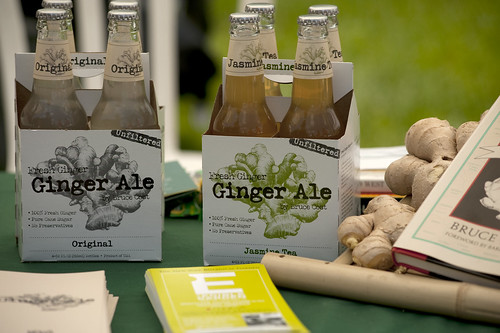Spice Up Your Life with Ginger
Posted in Gardening Tips on April 19 2011, by Sonia Uyterhoeven
 |
Sonia Uyterhoeven is Gardener for Public Education. |
The New York Botanical Garden and the American Society of Botanical Artists are co-hosting a juried botanical art show Green Currency: Plants in the Economy in the Arthur and Janet Ross Gallery from April 20-July 31.
The show–which opens tomorrow, April 20–features artists from 14 States and 8 countries. There are 43 works on botanical specimens that have economic importance whether they are used in medicine, food, clothing and shelter.
The works range from paw paws and pomegranates to pokeweed. In anticipation of the opening I would like to take a look at one of the entries: Ginger (Zingiber officinale). Ginger is a spice that carries me through the winter months; I add it to my salmon dishes for flavor and drink cupfuls of ginger tea to ward off sore throats and soothe my stomach. In my youth, consumption was centered on ginger ale and ginger bread cookies.
 The tan knobby fresh ginger you buy in the supermarket is a creeping, underground modified stem. Botanically speaking, the part we harvest and use is called a rhizome. Ginger is a 3-4 foot tall perennial with an almost bamboo-like appearance. It sends shoots or leaf stalks that have alternating leaves arranged on the same plane up from the rhizome.
The tan knobby fresh ginger you buy in the supermarket is a creeping, underground modified stem. Botanically speaking, the part we harvest and use is called a rhizome. Ginger is a 3-4 foot tall perennial with an almost bamboo-like appearance. It sends shoots or leaf stalks that have alternating leaves arranged on the same plane up from the rhizome.
Ginger is an old spice with a long history. It is indigenous to Asia from India to China. It has been used for centuries in Ayurvedic Indian and Chinese medicine. The Greeks and Romans used it to perfume their baths and viewed it as an aphrodisiac. Roman statesmen who felt their lives were threatened were rumored to drink herbal concoctions with ginger, cinnamon, frankincense, and myrrh to build up a tolerance to poison.
Ginger was an import commodity that was transported via the Silk Road from the East to the West. It was traded for livestock, silver, and gold. The distinctive flavor and odor of ginger come from three volatile oils gingeroles, zingerone and shogaols.
In medicine it is used for muscle pains, sore throats, as digestive aid, and to fight fatigue. These days you can find it in the cosmetic industry in bath salts and scented candles. The grocery store has it candied, preserved, dried, and fresh. The list of culinary uses are endless.
For a fun activity you can try and grow this tropical plant at home. Buy fresh ginger from the grocery store. Choose a well-branched piece that has lateral (side) buds. The buds will look like tiny horns. Plant it half in potting soil and half out and water carefully. Roots will form from the rhizome and the ginger will start to grow. Grow outside in the summer but remember to bring it indoors once the weather starts to cool.

